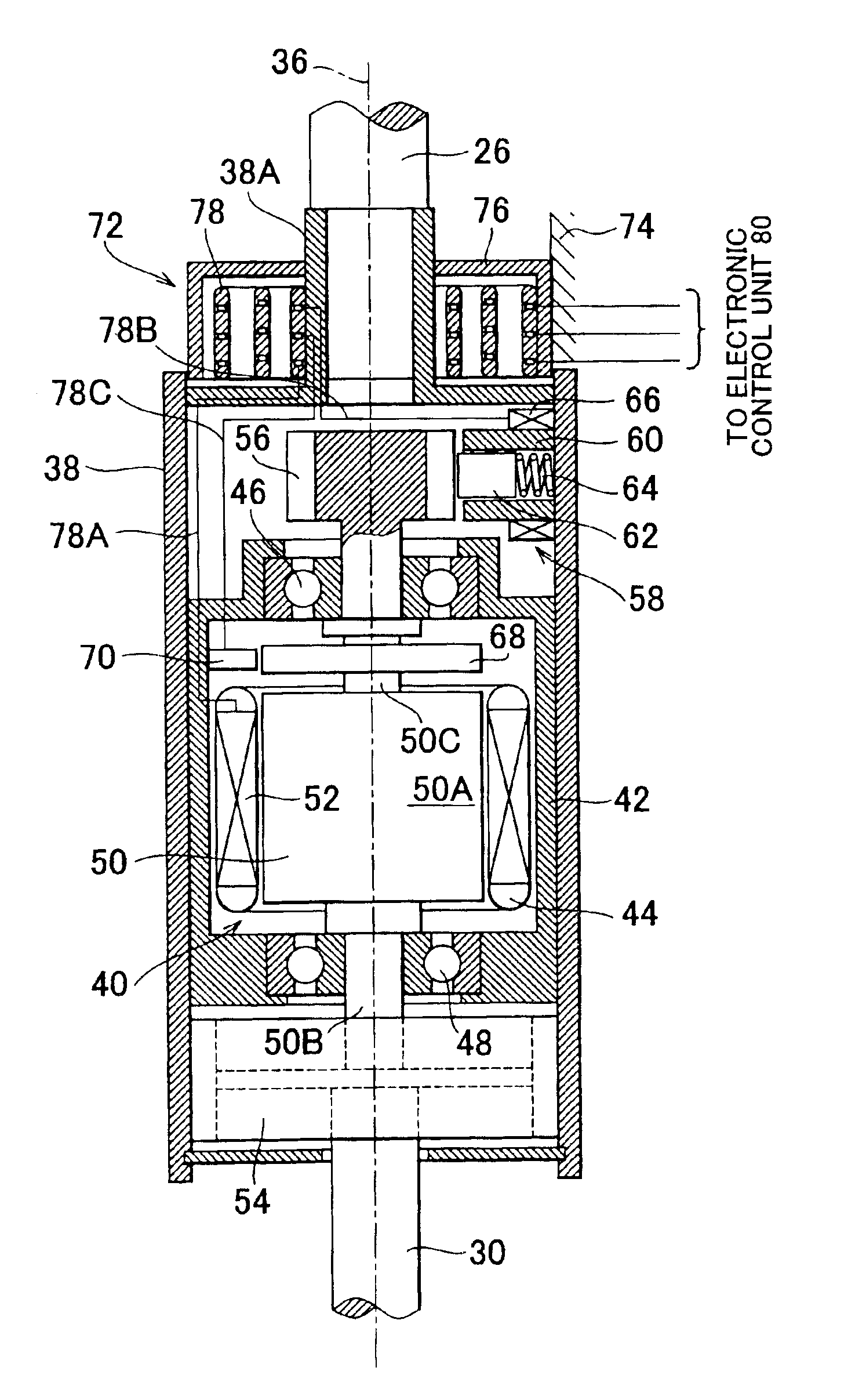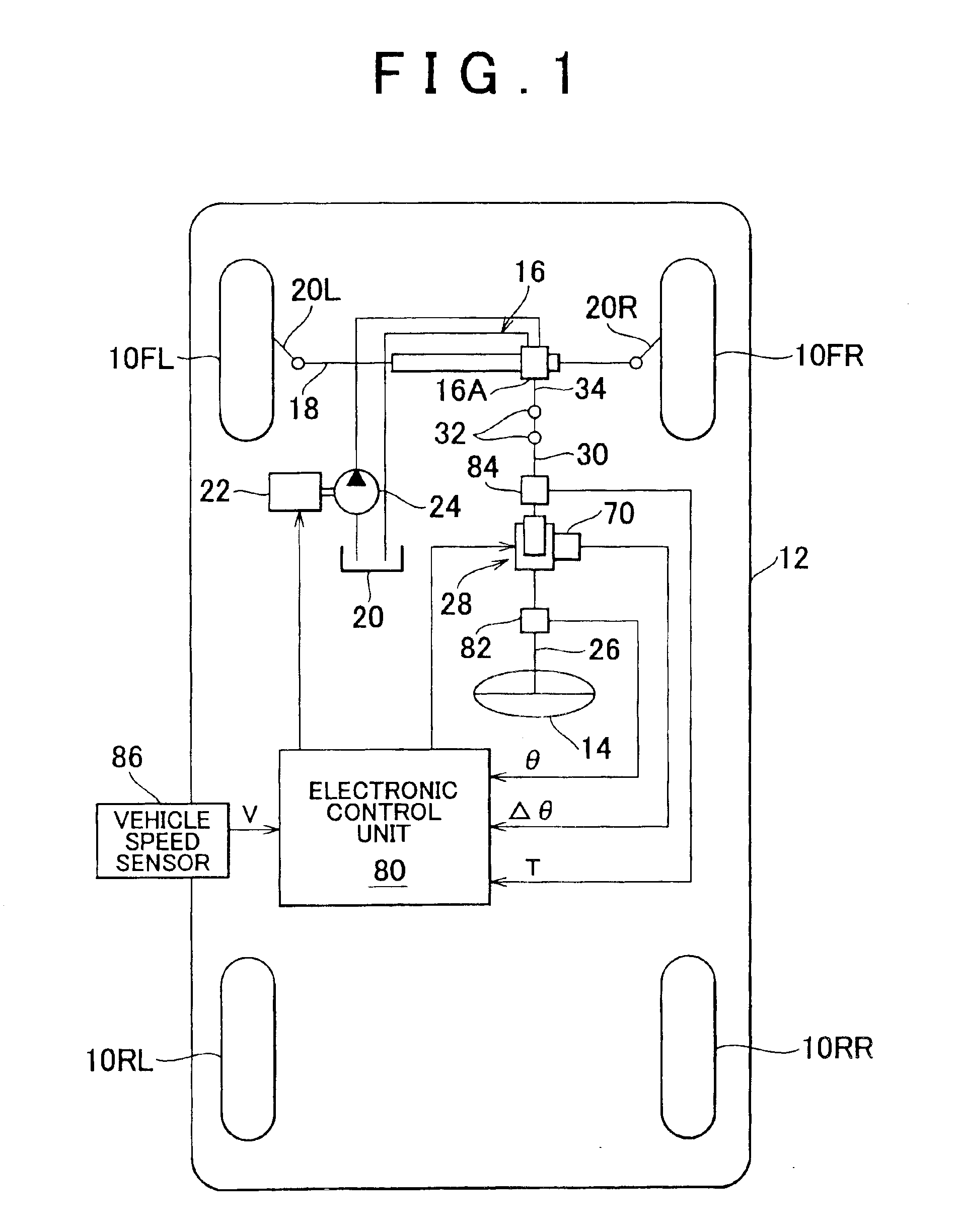Vehicular steering control device and vehicular steering control method
- Summary
- Abstract
- Description
- Claims
- Application Information
AI Technical Summary
Benefits of technology
Problems solved by technology
Method used
Image
Examples
first embodiment
[0037]FIG. 1 is a block diagram showing an overall arrangement of a vehicular steering control device in accordance with the first embodiment of the invention which is applied to a vehicle provided with a hydraulic power steering unit. FIG. 2 is an enlarged cross-sectional view of a steering gear ratio change unit shown in FIG. 1.
[0038]Referring to FIG. 1, reference symbols 10FL and 10FR denote front-left and front-right wheels of a vehicle 12 respectively, while reference symbols 10RL and 10RR denote rear-left and rear-right wheels of the vehicle respectively. The front-left and front-right wheels 10FL and 10FR as steering wheels are turned by a hydraulic power steering unit 16 of rack-and-pinion type via a rack bar 18 and tie rods 20L and 20R. The hydraulic power steering unit 16 is driven in response to operation of a steering wheel 14 by a driver.
[0039]In the illustrated embodiment, the hydraulic power steering unit 16 has a control valve 16A having a known structure. High-press...
second embodiment
[0070]The aforementioned first embodiment is suited for cases where the electric motor can precisely control rotational angle, for example, as in the case of a stepper motor. However, the second embodiment and the third embodiment that will be described later are suited for cases where the electric motor is a motor constructed, for example, as a direct-current motor and where a rotational angle to be created by the electric motor is subjected to feedback control.
[0071]Next, a steering gear ratio control routine in accordance with the second embodiment will be described with reference to a flowchart shown in FIG. 8. In FIGS. 8 and 3, like steps are denoted by like step numbers.
[0072]In the second embodiment, step 11 follows step 10. It is determined in step 11 whether or not a relative rotational angle Δθ which is formed between the upper steering shaft 26 and the lower steering shaft 30 and which has been detected by the rotational angle sensor 70 has exceeded a reference value Δθta...
third embodiment
[0078]FIG. 9 is a flowchart showing a steering gear ratio control routine in accordance with the third embodiment. In FIGS. 9 and 3, like steps are denoted by like step numbers.
[0079]In the third embodiment, step 21 follows step 20. It is determined in step 21 whether or not a target relative rotational angle Δθt which is formed between the upper steering shaft 26 and the lower steering shaft 30 and which has been calculated in step 20 has exceeded a reference value Δθtrs (a positive constant that is smaller than and close to Δθtarmax) in the right-turn direction. If an affirmative determination is made, the control operation proceeds to step 26. If a negative determination is made, the control operation proceeds to step 22.
[0080]It is determined in step 22 whether or not a target relative rotational angle Δθt which is formed between the upper steering shaft 26 and the lower steering shaft 30 and which has been calculated in step 20 is below a reference value Δθtls (a negative const...
PUM
 Login to View More
Login to View More Abstract
Description
Claims
Application Information
 Login to View More
Login to View More - R&D
- Intellectual Property
- Life Sciences
- Materials
- Tech Scout
- Unparalleled Data Quality
- Higher Quality Content
- 60% Fewer Hallucinations
Browse by: Latest US Patents, China's latest patents, Technical Efficacy Thesaurus, Application Domain, Technology Topic, Popular Technical Reports.
© 2025 PatSnap. All rights reserved.Legal|Privacy policy|Modern Slavery Act Transparency Statement|Sitemap|About US| Contact US: help@patsnap.com



